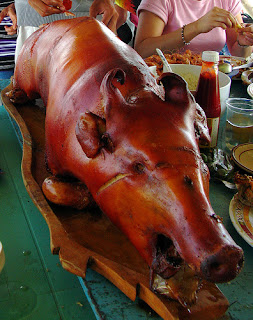A recent study conducted by a team of researchers from the Brookhaven National Laboratory in Upton, New York found that overeating is really an addiction, like any other addiction to drugs, alcohol etc. It has been known for a long time now that many people may develop an addiction to eating, eating disorders and poor eating habits. But the new study is important, because it shows that there is a close connection between stomach and the brain. More exactly, the stomach of those addicted to overeating is linked to the hippocampus area of the brain, the same neural region which is involved in drug addiction.
The hippocampus is the area of the brain mostly concerned with the memory and emotions. Besides the hippocampus, overeating also stimulates the frontal cortex region of the brain. "We found that areas of the brain that received signals were the hippocampus, which is involved in memory and emotion, and also the frontal cortex," wrote Dr. Gene-Jack Wang and his team in the report published in the Proceedings of the National Academy of Sciences. He added that "similar brain circuits underlie the enhanced motivational drive for food and drugs seen in obese and drug-addicted subjects, respectively."
The team explained that signals from the stomach to the hippocampus region of the brain are the key-factor which triggers overeating and obesity. Researchers also cautioned that even if one who used to be overweight and obese lost weight and has a normal BMI, he is still at the risk of gaining weight again, as the link between the hippocampus and stomach preserves within his body. "An obese person, even if he becomes lean, still has the signals in the area of the hippocampus, so there is a high likelihood that he will relapse," explained Dr. Wang.
However, things are not that tragic and pessimistic as they may seem at a first view. Dr. Mark Gold, Professor of Psychiatry and Neuroscience at the University of Florida's McKnight Brain Institute pinpointed the fact that knowing which bodily mechanism triggers overeating and eating disorders is very useful for medical experts, as it may help in the development of new ways to combat obesity. "The advantage of having a novel hypothesis means that we might be able to develop new treatments for obesity similar to those for drugs of abuse. This opens a whole range of treatment possibilities," he said.
The only question which still remains unanswered until further research - the most difficult question, in fact - is how the information can be used in order to efficiently fight against obesity. Dr. Wang suggested that new methods of treating obesity and overeating may be linked to emotions, like in the case of drug addicts. "That is the million-dollar question. We must study to learn more about how the signal is transmitted and how to treat obesity. As with drug addiction, we might also have to treat the emotions," the leader of the study said.
The hippocampus is the area of the brain mostly concerned with the memory and emotions. Besides the hippocampus, overeating also stimulates the frontal cortex region of the brain. "We found that areas of the brain that received signals were the hippocampus, which is involved in memory and emotion, and also the frontal cortex," wrote Dr. Gene-Jack Wang and his team in the report published in the Proceedings of the National Academy of Sciences. He added that "similar brain circuits underlie the enhanced motivational drive for food and drugs seen in obese and drug-addicted subjects, respectively."
The team explained that signals from the stomach to the hippocampus region of the brain are the key-factor which triggers overeating and obesity. Researchers also cautioned that even if one who used to be overweight and obese lost weight and has a normal BMI, he is still at the risk of gaining weight again, as the link between the hippocampus and stomach preserves within his body. "An obese person, even if he becomes lean, still has the signals in the area of the hippocampus, so there is a high likelihood that he will relapse," explained Dr. Wang.
However, things are not that tragic and pessimistic as they may seem at a first view. Dr. Mark Gold, Professor of Psychiatry and Neuroscience at the University of Florida's McKnight Brain Institute pinpointed the fact that knowing which bodily mechanism triggers overeating and eating disorders is very useful for medical experts, as it may help in the development of new ways to combat obesity. "The advantage of having a novel hypothesis means that we might be able to develop new treatments for obesity similar to those for drugs of abuse. This opens a whole range of treatment possibilities," he said.
The only question which still remains unanswered until further research - the most difficult question, in fact - is how the information can be used in order to efficiently fight against obesity. Dr. Wang suggested that new methods of treating obesity and overeating may be linked to emotions, like in the case of drug addicts. "That is the million-dollar question. We must study to learn more about how the signal is transmitted and how to treat obesity. As with drug addiction, we might also have to treat the emotions," the leader of the study said.
Source:
Softpedia News
http://news.softpedia.com/



